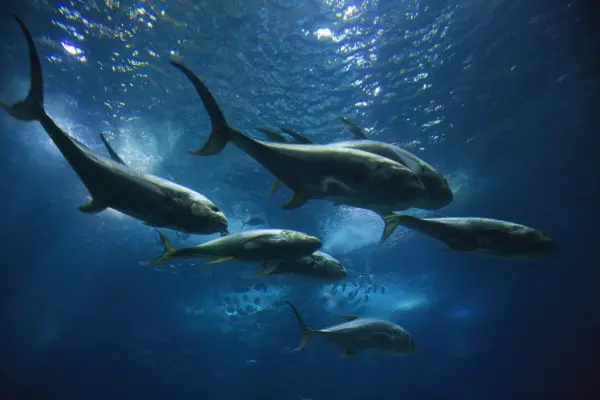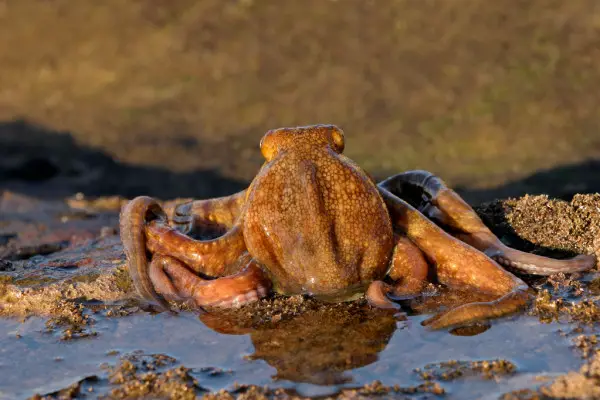What Is The "Backbone" Of The Animal And What Are The Different Sections?
When watching a fish swim, you lot might be charmed by the grace many species brandish. While they have entire systems designed to propel them, it's piece of cake to recognize that their skeleton plays a major office in their motion. Fish seem so fluid and flexible that information technology begs the question do fish have backbones ?!
Table of Contents
- Vertebrates vs Invertebrates
- What Are Invertebrates?
- Do All Vertebrate Fish Take a Courage?
- What is the Courage for in a Vertebrate Fish?
- What is the Difference Between Cartilaginous Fish and Bony Fish?
- What Are Cartilaginous Fish
- What Are Bony Fish?
- Summary
Vertebrates vs Invertebrates

When diving into the question of fish backbones, nosotros need to first talk about vertebrates and invertebrates. Of the 2, all fish are vertebrates. Many fish species don't accept true basic, such as jawless fish, but the majority of aquarium fish do.
Backbones abound from an internal skeleton structure. This flexible bone back up structure surrounds the spinal cord, a bundle of critical nerves that leads to the encephalon. Ribs, limb bones, and other skeletal components protect vital organs and requite muscles a identify to anchor.
What Are Invertebrates?
Invertebrates include animals like jellyfish, insects, spiders, squid, and starfish. They are called invertebrates considering they lack a backbone.

Some invertebrates instead use an exterior skeleton (exoskeleton) that acts like a suit of armor. The benefit is that their soft flesh isn't and so exposed to the elements and predators.
But the downside is that an exoskeleton tin't grow along with the soft internal organs. That's why the bulk of invertebrates with hard parts accept to shed their skins periodically.
Unfortunately for them, this is dangerous since predators love zip more than a freshly molted crab or spider that's soft and defenseless.
Do All Vertebrate Fish Take a Backbone?
Yeah, all fish take a backbone of some sort. While it isn't always fabricated of bones, As vertebrates (chordates), a backbone is the defining characteristic of this group of animals! Their body plan includes a backbone, cartilaginous rod, naked nerve string, or other main skeletal structure. From this connective tissue, internal organs and other body parts branch out from it.
Chordates (phylum Chordata) is one of the about familiar classifications for animals. It includes non only fish but amphibians, reptiles, birds, and mammals like u.s.! All chordates have a familiar bilateral symmetry that's very obvious when looking at the skeleton and all their vital organs.
In their eggs, embryonic, or larval stages, all chordates accept a primitive notochord that is the precursor to true courage development. This notochord is similar to that found in tunicates and other primitive chordate ancestors.

What is the Backbone for in a Vertebrate Fish?
Fish have backbones in order to provide structure and support for their muscles, organs, and the other basic in their bodies. The backbone is used the same style in the bodies of other vertebrates also, including animals similar mammals and birds.
What is the Difference Between Cartilaginous Fish and Bony Fish?
What Are Cartilaginous Fish
The start thing that might stand out to you is the give-and-take "cartilaginous," from the word cartilage. This group includes sharks, rays, skates, and sawfish. Rather than bone, they have softer cartilage to provide structure for their bodies.
Other fish are classified as bony fishes: fish that use basic in their skeleton. This includes the bulk of aquarium and game fish.
Many cartilaginous fish also abound their backbones using a very different process from bony fish. Using specialized cells called somites, they form their cartilaginous backbone.
What'south interesting well-nigh this is that country-dwelling vertebrate species, including birds, mammals, and humans, use somites to form their backbones.
Bony fish, on the other paw, are unlike all other vertebrate animals. They utilize a mixture of somites and cells called chondroblasts to class their backbone bone structure.
This suggests that sharks, rays, and other cartilaginous fish are much more than just "primitive fish." They are very distinct in a number of ways and closer in some respects to land-dwelling vertebrates!
What Are Bony Fish?
Bony fish have backbones like other vertebrates. There are two clades (groups) within this category: the ray-finned fish, which have thin membranes held up with rays.
And the lobe-finned fish, which accept fleshy paired fins that somewhen evolved into limbs for ancestral amphibians. Lobe-finned fish nonetheless alive today include the many kinds of lungfish as well as the prehistoric-looking Coelocanth.

The just exception is a bony fish that blurs the boundaries between bony and cartilaginous fish: the hagfish. Affectionally known every bit the "snot eel," they are the only animal known with a proper skull however no spinal column!
They do have rudimentary vertebrae that accept almost entirely disappeared. Just instead of a spinal cavalcade, they have a cartilaginous cord running along their spinal nerve.
Hagfish are also some of the just jawless fish left in the world, aslope the lamprey. The rest were some of the commencement vertebrates simply evolved into different forms or went extinct millions of years earlier.
So why would a fish surrender its vertebral cavalcade when other vertebrates don't? The answer is in how hagfish feed and defend themselves!
The snot eel has the power to literally tie itself in knots! They do and then in lodge to gain leverage when ripping chunks of rotting flesh from dead fish (lampreys prefer live fish).
And if that wasn't gross enough, they too expel copious amounts of blueish slime when they experience threatened.
The slime from a single hagfish tin can clog a predator's gill openings and brand an entire bucket of water sticky! Past losing their backbone, hagfish gained the ability to be impossibly flexible.
Summary
Since fish are vertebrates, the spinal column forms the body's main structure from which other bones, muscles, and organs co-operative off from. Therefore, all fish take backbones and rely on them to support their body parts.
Cartilaginous fish and one species of bony fish (hagfish) bend this rule, though, since they rely on cartilage as a support construction rather than a vertebral column like about fish. Other fish have small amounts of cartilage in their skeletons but not nearly equally much every bit cartilaginous ones.
This is the contrary of invertebrates, animals which don't have a courage or any other bones. Or they apply a tough outer exoskeleton for a defense that needs to be shed in society for the animal to grow.
I hope you've appreciated this dive into what makes the vertebral column and then essential non only to fish propulsion and evolution but how they compare to other animals and invertebrate species! Let me know your thoughts if any other questions ascend!
Frequently Asked Questions:
- Can fish swim backwards?
- Saltwater or freshwater aquariums?
- Why practice fish chase in the tank?
- Tin fish cry at all?
- Author
- Recent Posts
![]()
Source: https://aquariumlabs.com/do-fish-have-backbones/
Posted by: guerrabetion.blogspot.com

0 Response to "What Is The "Backbone" Of The Animal And What Are The Different Sections?"
Post a Comment